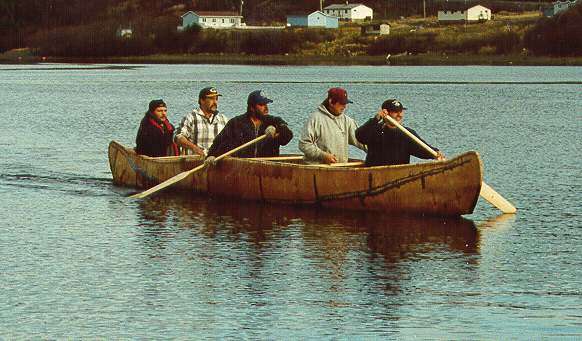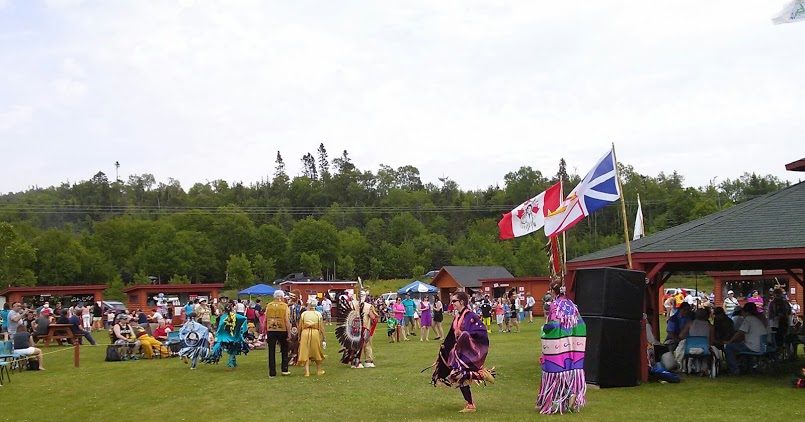The ancient name of our community is Miawpukek, which is L’nui’simk for “Middle River”.

U’n (fog) on the great Conne River
Photo credit: Scott Oosterom
Time Line
1602 – Sailors on an English ship commanded by Bartholomew Gosnold saw six Lnu’k traders in a Basque Chaloupe of New England coast. The Lnu’k knew about Newfoundland and mentioned Placentia.
1616 – Father Pierre Biard, Jesuit priest, was estimating that there were 10,000 Lnu’k from Chouacoet to Newfoundland.
The Immigrating Nations’ records available thus far have many references in the 17th century of our people’s presence in Ktaqmkuk, but mostly as warriors and allies of Ni’kmaq Françoise (Our French allies). We were indeed allies and friends to the Françoise. Unlike the English who called us savages and sought to take everything from us physically and mentally, the Françoise called us Sauvages (Of the country), treated us as equals, lived with us, married into our families.
Their records are peppered with accounts of
our people on the South Coast from 1707 onward but records uncovered to date
only mention our presence in Lapite’spe’l (Baie de Espoir) around 1765. (Lapite’spe’l
actually refers to Lampidois Passage).
1720, Dec. 17 – Samuel Glendhill, English Lieutenant Governor at Placentia reports “there was two open boats full of Indians seen from St. Peter’s (Saint-Pierre Island) but suppose’d to be only a party hunting from the main (Nova Scotia) etc. For they have done no damage”[1]
Our ancestors came to Ktaqmkuk in time out of memory either by way of the Strait of Belle Island from Labrador or by way of the Cabot Strait from Unama’kik.
In 1922 the ethno historian Frank G. Speck wrote, “Throughout Newfoundland the Indians (Mi’kmaq) refer to their predecessors as SAYEWDJKIK (Sáqwéjíjk), the “Ancients”, speaking of them as though they were the first inhabitants of the Island. Some of the older Micmac-Montagnais even claim that the Sayewdjkik antedated the coming of the Beothuk. Ignoring such testimony, I think we may conclude that the term simply refers to the earlier Micmac colonists from the mainland, whose numbers were few and whose isolation rendered them distinct in some respects in culture and possibly in dialect.

These people are believed to have been true Micmac and to have had a complete native nomenclature for the prominent places in the island. Some of the older Indians recall hearing about the last of these Sayewdjkik in the person of an old blind woman who died in Sydney [Nova Scotia] many years ago.
Although over one hundred years of age, she was conveyed in a canoe by her relatives, at her own request, over a large part of Newfoundland, giving the various lakes, rivers and mountains their proper names according to the ancient terminology…The Sayewdjkik families are said to have become completely merged with the later comers from Cape Breton and Labrador.
He also wrote his informants asserted that they had crossed the “Cabot Strait” by canoe: “The route lay between Cape North (of Cape Breton) and Cape Ray on the South-western coast of Newfoundland, a distance of sixty miles, land being dimly visible in fine weather. This bold journey was ordinarily accomplished in two days, they say.” On a calm night a party of canoeists would set out for Tuywegannmikuk (Temporary Goal Island) or as it is called today St. Paul’s Island. From here a party of “three sturdy canoe men” continued the journey to Cape Ray. “Landing here, they would await calm weather, then build an immense beacon fire on the highlands to serve both as a signal for advance and a guide for direction through the night.” The rest of the party would thus complete the journey. [2]

Courtesy: https://www.heritage.nf.ca/articles/aboriginal/mikmaq-culture.php
1744 – Conne River marked as “Conega” on maps.
1755 – Conne area marked as “B. Connaigre” on maps.
1802 – Most entries in Mi’kmaq history book in Mi’kmaw language. The record shows at this time only two families were in the settlement then, both were Jeddores.[3]
1807 – Conne marked as Conne River on map.
1825 – The first child was born in Conne River about 125 years ago (1825) and was baptized by a traveling priest.[4]
1836 – First mass in Conne River in a very rough dwelling house.[5]
1864 – First burial ground at Conne consecrated. Up to this time, people were buried at Weasel Island – 75 reported burials at Weasle Island.[6]
1869 – Family heads of households recorded by Alexander Murray as potential recipients for grants of land at Conne River: Maurice Lewis, Joseph Bernard, Mathew John, Bernard John, Nicholas Gidor (Jeddore), Peter Gidor (Jeddore), Daniel Boombou (Bumble), Daniel Berntim, Mathew Brazil, Joseph Brazil, Lewis John, Beneheimen (Benjamin) Lewis, Noel Joe, John Michial (Mitchell), Solome Bobit, Edward Bobit, Noel Lewis, Joseph Lewis, John Burke, George Benet (Benoit), Peter Strait (Stride), John Mikitonal (Mac/McDonald), Joseph Paul, Peter Joe, Peter John.[7]
Miawpukek was a well-established Lnu’k occupation site even before 1870. We Lnu’k believe we have always been in Ktaqmkuk. Lnu’k occupied all of Baie d’ Espoir long before any Immigrating Nations’ peoples even set foot on Ktaqmkuk, (the L’nu name for Newfoundland).
1870, May 27 – Official establishment of Conne River as a reserve. From the Minutes of the Executive Council note “a grant of land [be given] to the Indians of Conne River, Bay d’Espoir; – The Council concurred in the propriety of the application and referred the matter to the hon. Surveyor General with the view of carrying its object into effect”.
1908, Jan. 17 – First school opens in Miawpukek. Ann Matthews was first teacher. She was replaced with Michael McDonald (taught for 12 years. 1923) by St. Croix who subsequently appointed only English teachers.
1925 – Saqamaw Noel Jeddore is forced into exile by Fr. St. Croix to Eskasoni, Unama’kik. Many of his people follow him into exile, never to return to their homes.
1983, April 21 – Nine-day hunger strike begins – Misel Joe, Billy Joe, Andy Joe, Ches Joe, George Drew, Wilfred Drew, Rick Jeddore, Aubrey Joe, and Michael G. Benoit stepped up against the Newfoundland government in order to get funds released to the community. On April 30, 1983, the government released the funds.
1987, June 25 – Miawpukek First Nation officially recognized as a reserve under the Indian Act of Canada. Three years following the initial application in 1984.
1997 – First Annual Miawpukek First Nation Powwow is held.

1999, July 18 – Saqamaw Mise’l Joe, along with Donny Benoit, Gerard Jeddore, Andrew Joe, Ricky Jeddore and Sulia’n Joe landed at our holy site of Chapel Island, Unama’kik (Cape Breton) having paddled a birch bark canoe, SAPE’UTKWJU’SN, from Cape Ray, Ktaqmkuk.
This trip was planned and made to both commemorate and prove that such journeys were indeed made by our forefathers. We built the canoe using traditional methods, materials and tools.
For Additional Information
Heritage Newfoundland & Labrador
https://www.heritage.nf.ca/browser/subject/Mi’kmaq
References
Many of our stories are passed down orally; there is no written or recorded documentation. Every effort to make references to historical events was made where possible. Thank you to Phillip Jeddore providing some of this information.
[1] From: CSPCS 1933:216-217 by Martijn, 1996. https://journals.lib.unb.ca/index.php/NFLDS/article/download/1002/1354
[2] 1922, Speck, Frank G., Beothuk and Micmac. Indian Notes and Mongraphs, Miscellaneous Series No. 22. Museum of the American Indian. Heye Foundation, New York. Pp. 123-124.
[3] Holy Cross Annals, 1951, Pp 51.
[4] Holy Cross Annals, 1950
[5] Translations by Joe Jeddore in 1836 of some entries in a Mi’kmaw history book.
[6] From an old and interesting book owned by Joe Jeddore. Written in Holy Cross Annual of 1951. Most of entries in Mi’kmaw language. Shows history of Conne River from 1802, page 51
[7] Murray’s notebook, copied by Robert Cuff, November 1998 and entered by Gerald Penney, 03 December 1998.
